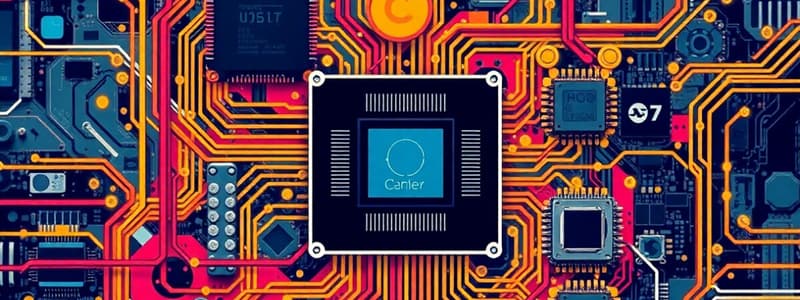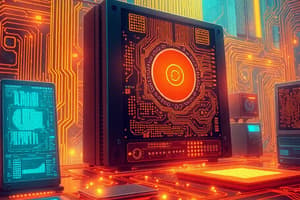Podcast
Questions and Answers
What is one of the primary purposes of IT security?
What is one of the primary purposes of IT security?
- To promote social media engagement
- To increase internet speed and connectivity
- To enhance software development practices
- To protect computer systems from unauthorized access (correct)
Why are regular security audits necessary?
Why are regular security audits necessary?
- To detect and address vulnerabilities in systems (correct)
- To increase the amount of data collected
- To enhance cloud computing capabilities
- To improve the user interface of applications
What ethical issue arises from the use of IT resources?
What ethical issue arises from the use of IT resources?
- The speed of internet connections
- The automation of simple tasks
- The efficiency of data processing
- Data privacy and intellectual property rights (correct)
What role does big data technology play in IT?
What role does big data technology play in IT?
Which of the following is an emerging trend in IT?
Which of the following is an emerging trend in IT?
Which of the following best describes information technology?
Which of the following best describes information technology?
What is the primary role of system software in a computer?
What is the primary role of system software in a computer?
What is a database management system (DBMS) used for?
What is a database management system (DBMS) used for?
Which of the following is a key benefit of cloud computing?
Which of the following is a key benefit of cloud computing?
What are Local Area Networks (LANs) primarily used for?
What are Local Area Networks (LANs) primarily used for?
Which type of device is classified as a peripheral in information technology?
Which type of device is classified as a peripheral in information technology?
What is the primary concern related to data management in IT?
What is the primary concern related to data management in IT?
Which of the following components primarily performs specific tasks for users?
Which of the following components primarily performs specific tasks for users?
Flashcards
IT Security
IT Security
Protective measures like firewalls, antivirus software, and encryption used to safeguard computer systems and data from unauthorized access, modification, or destruction.
Vulnerability
Vulnerability
A potential exploit or weakness in a system that could allow unauthorized access or compromise data integrity.
Ethical Implications of IT
Ethical Implications of IT
The ethical considerations surrounding the use and development of IT systems, including concerns about privacy, bias, and misuse.
AI in IT
AI in IT
Signup and view all the flashcards
Internet of Things (IoT)
Internet of Things (IoT)
Signup and view all the flashcards
What is IT?
What is IT?
Signup and view all the flashcards
What are the goals of IT?
What are the goals of IT?
Signup and view all the flashcards
What is hardware?
What is hardware?
Signup and view all the flashcards
What is software?
What is software?
Signup and view all the flashcards
What is data management?
What is data management?
Signup and view all the flashcards
What is a computer network?
What is a computer network?
Signup and view all the flashcards
What is a LAN?
What is a LAN?
Signup and view all the flashcards
What is a WAN?
What is a WAN?
Signup and view all the flashcards
Study Notes
Introduction to Information Technology
- Information technology (IT) encompasses computing, data storage, and communication for information processing, management, and dissemination.
- IT leverages hardware, software, networks, and data to solve problems, improve efficiency, and facilitate communication.
- IT systems are crucial for businesses, organizations, and individuals.
- IT constantly evolves with new technologies such as artificial intelligence and cloud computing.
Hardware Components
- Computers (PCs, servers, mainframes) are fundamental hardware components.
- Peripheral devices include input (keyboards, mice, scanners), output (printers, monitors), and storage (hard drives, flash drives).
- Network devices (routers, switches, modems) allow communication.
- Mobile devices (smartphones, tablets) are increasingly important.
Software Components
- Software programs instruct computers on tasks.
- System software (e.g., Windows, macOS, Linux) controls hardware and basic functions.
- Application software (word processors, spreadsheets, graphic design) performs specific tasks.
- Specialized software caters to particular needs (medical imaging, financial trading).
Data Management
- Data storage and management are critical to IT.
- Data is organized into databases (relational databases) for retrieval, analysis, and management.
- Database management systems (DBMS) create, maintain, and access databases.
- Data security and privacy are crucial, requiring robust protocols and measures.
Networking
- Computer networks connect devices for data sharing and communication.
- Local Area Networks (LANs) connect devices locally.
- Wide Area Networks (WANs) connect devices over larger distances (e.g., the internet).
- Cloud computing provides internet access to computing resources.
Security
- IT security protects systems and data from unauthorized access, use, disclosure, disruption, modification, or destruction.
- Security measures include firewalls, antivirus software, encryption, access controls, and intrusion detection systems.
- Emerging security threats necessitate continuous monitoring and response.
- Data breaches often stem from system vulnerabilities or human error, requiring regular security audits.
Ethical Considerations
- Ethical implications arise with sophisticated IT systems' pervasiveness.
- Issues around data privacy, intellectual property rights, and algorithmic bias are crucial.
- Responsible and ethical IT resource use is vital across developers, users, and organizations.
Emerging Trends
- AI and machine learning alter IT applications, impacting analysis, automation, and decision-making.
- The Internet of Things (IoT) connects everyday devices, creating new possibilities and challenges.
- Big data technologies analyze massive datasets for deeper insights.
- Cloud computing's role in scalability, flexibility, and cost-effectiveness is expanding.
Studying That Suits You
Use AI to generate personalized quizzes and flashcards to suit your learning preferences.




